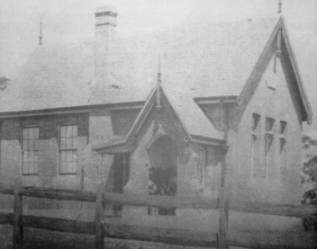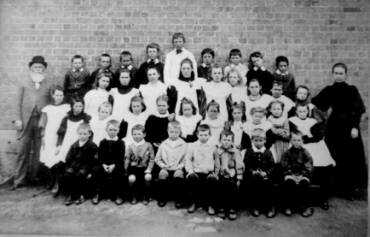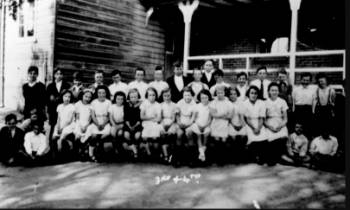SLICE OF LIFE: BAULKHAM HILLS PUBLIC SCHOOL
Education in Baulkham Hills was first provided at the Roman Catholic St. Michael's Denominational School from 1862 until 1867 when the school was temporarily closed by the lack of a teacher. George Frederick Hughes had recently opened a small school in a large room of a brick house called "Marooba" situated at 238 Windsor Road Baulkham Hills. In December 1868 it became Baulkham Hills Provisional School. School registers show that there were initially 27 students of the Tuckwell, Jenner, Fishburn, Cowell, Brien, Billett, Allsop, Noakes, Burton and Dellow Families. In 1871, when the school population consisted of 26 boys and 16 girls, moves were begun to convert the school to a Public School. Unfortunately, due to Mr Hughes receiving a poor inspection report, the school was closed temporarily and the school books and maps etc. were handed to the head-teacher of the Church of England Denominational School at Castle Hill.
After much correspondence and money spent on enlarging the existing classroom at Baulkham Hills by four feet, a Public School was opened on 4th January 1874 with Mr J. Burgess Born appointed teacher. John Worrall replaced him later in the year. In 1875 plans for a new school house and teacher's residence were drawn up and the land opposite was purchased from James Pearce on 22nd January 1876. Hart and Lavor of Parramatta were given the building contract on 12th April 1876 at 1,077 pounds to be completed in six months. The final certificate for the new school building was issued on 2nd November 1876 and the school opened soon afterwards.

Baulkham Hills Public School Building
Although new school buildings had been provided, not everyone was satisfied, as witnessed by Mr Worrall's letter to the Council of Education in February, 1878: -
"I have the honour to intimate that the wall of the Teacher's Residence which faces the south east, is completely saturated with water, owing to the rain soaking through the bricks; thereby causing the rooms to be very damp, and almost unfit for habitation; the walls being overgrown with red fungus inside two rooms."
As a remedy to this problem, the outside walls of the residence were painted, and in the same year a weathershed was provided for the pupils at a cost of 60 pounds. Twenty-five trees were planted on the first Arbor Day Celebration in 1890, with a further 105 trees and shrubs planted by Arbor Day the following year.
During the 1890s correspondence between Mr Worrall and the Department of Public Instruction indicated that average attendance had dropped due to sickness of the pupils, many wet days and parents needing their children to help the family during the fruit picking season.
One child was temporarily blinded from bee stings resulting from Mr Worrall having more than 100 hives in the playground. He was required to reduce this to 50.

Headmaster John Worrall and his daughter with the school pupils 1890
Mr Worrall retired as headmaster in 1902 after being at the school for 27 years (with some assistance from his daughter) and was replaced by Charles Sattler, followed by William Kimber. On arrival in 1905, Mr Kimber rented premises as the school residence needed renovating. At this time it had a grey shingle roof, a hallway with two rooms on each side and one room on the back with a separate kitchen. In 1906 a room was added and improvements made to the building by Mr A.E. Gould at a cost of 92 pounds 10 shillings. The following year Thomas Hewson erected a new room on the south east side of the old building, connected to it by a porch at a cost of 323 pounds 17 shillings and 6 pence. He also carried out further repairs in 1910 including the writing of the name of the school on the front external wall in four inch block letters. A classroom, verandah, teacher's room and corridor were built by Cameron Brothers in 1918 costing 968 pounds 18 shillings and 6 pence. In 1924 the residence acquired an extra room making a total of 6 rooms and a kitchen at a cost of 291 pounds fifteen shillings and renovations were also carried out costing 138 pounds 10 shillings.
In 1906 there were 80 children on the roll and an average attendance of 60 pupils. Jean Belschner, daughter of Mr Kimber, recollected (in an interview about twenty years ago with local historian Harry Carr) that when she started school at Baulkham Hills she was taught by a Miss Marr, a devout Methodist who was"a stout lady with grey hair arranged in a pompadour style, she fed us stories from the Bible and is is no wonder that I became rather an authority on the Bible because it was poured into me."
Jean and her friend Ivy Hunt " used to both take a book and sit and read to each other at playtimes· that made everyone laugh because they thought that was a funny way for children to entertain each other."
She also remembered her brother falling on a pile of old roof shingles (with nails still protruding) which had been replaced by an iron roof and a dog named "Gallipoli" being cared for at the school whilst its owner fought in World War One. Her father retired and was replaced by James Jamieson in 1918.
The original school site was one and a half acres with a frontage to Windsor Road. It was enlarged in 1926 by just over one acre and again in 1947 and 1948 when a number of lots were acquired from various owners. A four-classroom timber unit costing 8548 pounds was opened in 1956 and five more classrooms were erected between 1960 and 1965. One of the small rooms in the original building was used as a sewing room and the first school library. An additional two acres of land were resumed in 1959 and a further two acres purchased in 1961 thereby increasing the site to eight and three quarter acres.

3rd and 4th Class Pupils at Baulkham Hills Public School 1950
In 1969 headmaster Jack Stevenson ensured the playground was landscaped with large grassed play area and planted with Australian native shrubs and trees. A free standing library, and a two storey building with six classrooms and an administration area were erected in the early 1970s, followed by an assembly hall and canteen to complete the excellent facilities available to the children. In the late 1970s a Special Education Unit and 36 pupils arrived to enjoy a happy environment with sandpits, climbing equipment, fishponds and eventually a Living Skills Centre where the whole school cooked and participated.
One third of the school grounds was resumed for the M2 Hills Motorway which was opened in 1997. In November 1997 the Minister for Education and Training announced that Baulkham Hills Public School would close in December 1998. At the start of 1999 the remaining students joined Winston Hills Public School where their old school bell has been re-erected.
FURTHER READING
Baulkham Hills Public School 130th Anniversary Book / Baulkham Hills Public School, 1998
Baulkham Hills: a District Second to None / Pam Trimmer, 1990
Souvenir Magazine: Centenary of Education 1868 - 1968/ Baulkham Hills Public School, 1968
Photos courtesy The Hills District Historical Society PO Box 48 Castle Hill NSW 2154